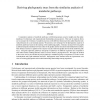1099 search results - page 49 / 220 » On the Complexity of Computing Evolutionary Trees |
106
click to vote
BMCBI
2005
14 years 9 months ago
2005
Background: Two central problems in computational biology are the determination of the alignment and phylogeny of a set of biological sequences. The traditional approach to this p...
ALGORITHMICA
2006
14 years 10 months ago
2006
Phylogenetic analysis is an area of computational biology concerned with the reconstruction of evolutionary relationships between organisms, genes, and gene families. Maximum likel...
CCS
2007
ACM
15 years 4 months ago
2007
ACM
Researchers have previously looked into the problem of determining if a given set of security hardening measures can effectively make a networked system secure. Many of them also...
ISMB
2003
14 years 11 months ago
2003
Comparative analysis of metabolic pathways in different genomes can give insights into the understanding of evolutionary and organizational relationships among species. This type ...
GECCO
2007
Springer
15 years 4 months ago
2007
Springer
In the longest common subsequence problem the task is to find the longest sequence of letters that can be found as subsequence in all members of a given finite set of sequences....




